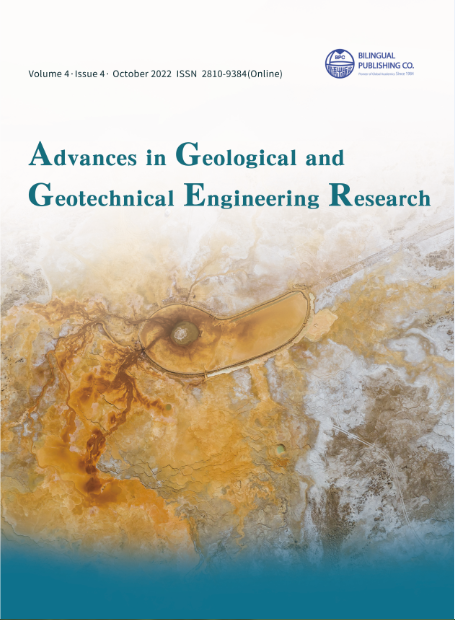-
148
-
147
-
131
-
124
-
117
Petrography and Geochemical Studies of Basement Rocks around Zango-Daji and Its Environs, North Central Nigeria
DOI:
https://doi.org/10.30564/agger.v4i4.5033Abstract
The geology of the Zango-Daji area was investigated petrographically and geochemically to determine the study area’s rock types and mineralization potential. The study area is underlain by rocks of the basement complex characterized by hilly and undulating rocks, which include granitic gneiss, migmatite gneiss, biotite hornblende granite gneiss, and pegmatites. Observation from the field shows that the study area is dominantly underlain by granitic gneiss. The granitic gneiss is dark grey, medium-coarse-grained, and characterized by weak foliation defined by the alignment of a streak of light and dark-coloured minerals. They are widespread in the area constituting about 70% of rock types found in the study area. The average modal percentage of minerals in the rocks from petrographic studies shows that granitic gneiss had quartz 45%, plagioclase 10%, microcline 20%, hornblende 2%, biotite 10%, muscovite 5%, kyanite 8% and other minerals 5%. Also, the pegmatite of the study area has no evidence of mineralization; it contains minerals like quartz, feldspars (microcline and orthoclase), and micas (mostly muscovite). Geochemical analysis of the granitic gneiss of the study area shows that silica is by far the most abundant with a value of 53.5%, Na2O value of 32.5%, Al2O3, and K2O of 6.1% and 4.0%, respectively. CaO value of 2.630% accounts for plagioclase feldspar in the granitic gneiss. The QAP diagram was used to determine the petrogenesis of the granitic gneiss. The plot shows the parent rock was a monzogranite with a low percentage of plagioclase in a thin section with a high percentage of quartz and alkali feldspar. The pegmatites of the study area are barren, as confirmed by the XRD result.
Keywords:
Gneiss; Hornblende; Migmatites; Pegmatite; PetrographicReferences
[1] Black, R., Caby, R., Moussine-Pouchkine, A., et al., 1979. Evidence for late Precambrian Plate tectonics in West Africa. Nature. 278(5701), 223-227.
[2] Burkey, K.C., Dewey, J.F., 1972. Orogeny in Africa. African geology. Ibadan University Press: Ibadan. pp. 583-608.
[3] Rahaman, M.A., 1976. Review of the basement geology of South Western Nigeria. Geology of Nigeria. Elizabeth Publishing Co.: Lagos. pp. 41-58.
[4] Imasuen, O.I., Onyeobi, T.U.S., 2013. Chemical compositions of soils in parts of Edo State, Southwest Nigeria and their relationship to soil productivity. Journal of Applied Sciences and Environmental. 17(3), 379-386.
[5] Oyawoye, M.O., 1964. The geology of the Nigerian Basement Complex—A survey of our present knowledge of them. Journal of Nigeria Mining, Geology and Metallurgical Society. 1, 87-103.
[6] Ozulu, G.U., Okoro, A.U., Ndubueze, V.O., 2019. Petrographic and geochemical interpretation of source provenance and tectonic setting of the Lokoja Sandstone, Bida Basin, Nigeria. International Journal of Advanced Geosciences. 8(2), 279-296.
[7] Obaje, N.G., 2009. Geology and mineral resources of Nigeria. Springer: Keffi.
Downloads
How to Cite
Issue
Article Type
License
Copyright © 2022 Simon D. Christopher, Onimisi A. Jimoh, Onimisi A. Martins

This is an open access article under the Creative Commons Attribution-NonCommercial 4.0 International (CC BY-NC 4.0) License.




 Simon D. Christopher
Simon D. Christopher






